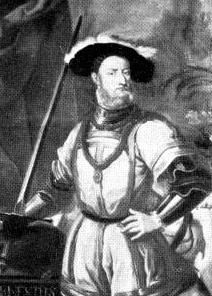Noble family House of Zahringen | Name Ernest, of | |
 | ||
Spouse(s) Elisabeth of Brandenburg-Ansbach-KulmbachUrsula of RosenfeldAnna Bombast of Hohenheim Father Christopher I, Margrave of Baden Born 7 October 1482Pforzheim ( 1482-10-07 ) Died 6 February 1553(1553-02-06) (aged 70)Sulzburg | ||
Margrave Ernest I of Baden-Durlach (7 October 1482, Pforzheim – 6 February 1553, Sulzburg) was the founder of the so-called "Ernestine" line of the House of Baden, the line from which the later Grand Dukes descended. He was the ruling Margrave of Baden-Pforzheim from 1533 and resided in Pforzheim from 1537. In 1565, his son Charles II moved the capital to Durlach and thereby changed the name of his country to Baden-Durlach. He had to deal with the upcoming Reformation and the frequent Ottoman wars in Europe. In this turbulent time, he tried to maintain a neutral position between the Protestants and Catholics. He did not participate in the Schmalkaldic War.
Contents
- Life
- The befitting marriage Elisabeth of Brandenburg Ansbach
- First morganatic marriage Ursula of Rosenfeld
- Second morganatic marriage Anna Bombast von Hohenheim
- References
Life
Ernest was the seventh son of the Margrave Christopher I of Baden and Ottilie of Katzenelnbogen.
Ernest was at first — like most of his brothers — destined for the clergy and was ordained in 1496 in Graben-Neudorf by the Vicar General of Diocese of Speyer. But he was not willing to renounce his inheritance and changed from a spiritual career to a military one. In 1509 he participated in the campaign of the Emperor Maximilian I against the Republic of Venice.
His father, Margrave Christopher I, proposed to make his fifth son, Philip I his sole successor, since Philip was most qualified to govern the country and Christopher wanted to avoid a division of his territory. On 18 June 1511, Christopher demanded that the Estates of Rötteln, Sausenberg and Badenweiler salute Philip, but they refused. On subsequent meestings of the Estates in Rötteln and in 1512 in Kandern, they refused to pay homage to Philip, because they would not be drawn into the internal struggles of the house of Baden. Ernest had threatened the Estates that he would respond with violence if they were to pay homage to his brother.
Ernest administered parts of Baden on behalf of his father from 1515 onwards, as did his brothers Philip I and Bernhard III. After Philip's death, Bernard III and Ernest divided the country into the Margraviates of Baden-Baden ("Bernhardine line") and Baden-Durlach ("Ernestine line"). The two parts were reunited in 1771 under Margrave and later Grand Duke Charles Frederick, a descendant of the Ernestine line, after the extinction of the other lines.
The befitting marriage: Elisabeth of Brandenburg-Ansbach
The Margrave first married on 29 September 1510 with Elisabeth of Brandenburg-Ansbach-Kulmbach (born: 25 March 1494; died: 31 May 1518), the daughter of Margrave Frederick I of Brandenburg-Ansbach-Kulmbach. They had the following children:
First morganatic marriage: Ursula of Rosenfeld
The Margrave's second marriage was in 1518 with Ursula of Rosenfeld (died: 26 February 1538), the daughter of George of Rosenfeld. This was a morganatic marriage. During Ernests's lifetime, it was controversial whether his son Charles could inherit the Margraviate. In the end, Charles could only inherit the margravite from his half-brother because the guardians of his cousins in the Bernhardine line did not object. In 1594, this morganatic marriage was cited in the imperial court as an argument when Margrave Ernest Frederick — a grandson of Ernest — contested the right to inherit of the children of Margrave Edward Fortunatus and Marie of Eicken.
They had three children:
Second morganatic marriage: Anna Bombast von Hohenheim
The Margrave married his third wife on 1 March 1544. She was Anna Bombast of Hohenheim (died: 6 June 1574). This marriage produced no children.
